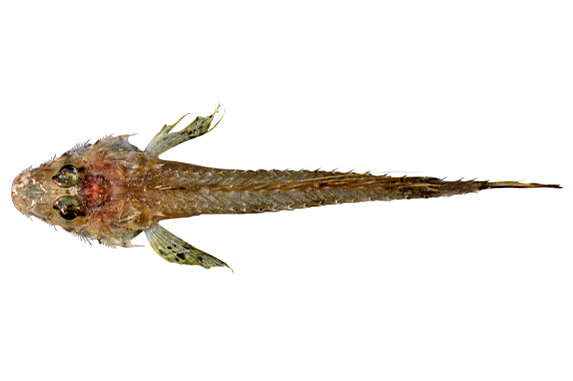Ogilby's Ghost Flathead, Hoplichthys ogilbyi McCulloch 1914

Ogilby's Ghost Flathead, Hoplichthys ogilbyi. Source: Australian National Fish Collection, CSIRO. License: CC by Attribution-NonCommercial
Ogilby's Ghost Flathead, Hoplichthys ogilbyi McCulloch 1914
More Info
|
Distribution |
Benthic on soft-bottom habitats of the outer continental shelf and upper continental slope (~115-353m) of eastern Australia from off Cairns, Queensland (~17o50'S) to off Wilsons Promontory (~39o04'S, 146o22'S), Victoria. Also unconfirmed records from the North West Shelf of Western Australia. |
|
Features |
Meristic features: Dorsal fin V-VI , 15-16; Anal fin I, 16-17; Pectoral fin 12-13 + 3-4;Pelvic fin I, 5; Lateral line (scutes/plates) 27-29 (usually 28); Gill rakers (including rudiments) 1-2 +11-12; Vertebrae 26. Body depressed, shallow (~5-8% SL), elongate, moderately narrow, tapering to very narrow caudal peduncle. Head moderately large (~29-33% SL), depressed, covered with numerous spines; eyes small to moderate in size (~15-24% HL); mouth moderately large (upper jaw length ~29-33% HL), not reaching anterior margin of eye, snout rounded, tip of lower jaw not protruding, teeth microscopic, villiform, arranged in narrow bands on the jaws, interrupted at symphyses, forming a narrow arched band on the vomer; vomer without posteriorly directed processes; palatine band narrow, almost linear. Lateral margin of head divided into four lobes, each with a distinct clump of spines laterally. These spines are located on the preorbital, first and second suborbitals and preoperculum. The first lobe also bears 1-2 strong spines projecting forward on the side of the snout. The fourth lobe includes the strong preopercular spine and a second smaller spine off this. Body without scales; lateral line with series of prominent bony plates, each bearing blade-like spine. Two dorsal fins, second dorsal fin highest, first with very weak spines, second spine longest, second dorsal fin rays bifurcate; anal fin similar to but lower than second dorsal fin, its origin well anterior to origin of second dorsal fin and terminating behind second dorsal fin (i.e. anal base longer than second dorsal fin base). Upper pectoral rays very long, lower ones decrease rapidly in length, second free ray is the longest and reaches to the base of the first anal ray, all are connected at their bases by membranes. Pelvic fins extend posteriorly to anus; caudal fin subtruncate to rounded (or pointed). |
|
Size |
Maximum length at least 197 mm (type). |
|
Colour |
Pink or yellow in life, with some very indefinite darker spots and lines; the back is crossed by six indistinct darker bands, of which the first is below the spinous dorsal, and the last on the caudal peduncle. First dorsal blackish with several darker wavy cross lines, and pectorals with some irregular rows of dusky spots. Second dorsal and caudal with indefinite spots. Eyes blue in life. In preservative: dorsal surface yellowish, the bands fading with age, sides and pale pink ventrally. Dorsal fins dark and dusky, pectorals pink yellow with irregular darker areas, caudal pink yellow, sometimes dusky distally. Eyes blue. |
|
Feeding |
Food items of Hoplichthys species include fishes and decapod crustaceans. |
|
Fisheries |
Although not targeted, this species is usually taken by-catch in commercial trawls. |
|
Species Citation |
Hoplichthys ogilbyi, McCulloch 1914, Biological Results Endeavour 2(3) :133, Figs. 1-1a; Pl. 28, 36.5 miles north, 12°E of Cape Moreton, Queensland, Australia, depth 73 fathoms. |
|
Author |
CSIRO Marine & Atmospheric Research |
Ogilby's Ghost Flathead, Hoplichthys ogilbyi McCulloch 1914
References
May, J.L. & Maxwell, J.G.H. (1986) Field guide to the trawl fish from temperate waters of Australia. CSIRO Division of Fisheries Research, Hobart. 492pp.
McCulloch, A.R. (1914) Report on some fishes obtained by the F. I. S. "Endeavour" on the coasts of Queensland, New South Wales, Victoria, Tasmania, South and South-western Australia. Part II. Biol. Results "Endeavour" v. 2 (pt 3): 77-165, Pls. 13-34.
McGrouther, M.A. (1999). Family Hoplichthyidae. Pp. 2422-2424 In Carpenter, K.E. & Niem, V.H. (eds). The Living Marine Resources of the Western Central Pacific. FAO Species Identification Guide for Fisheries Purposes. Rome. FAO Vol. 4 pp. 2069-2790.
Paxton, J.R., Gates, J.E. McGrouther, M.A. & Hoese, D.F. (2006). Hoplichthyidae (pp. 949-950). In: Zoological Catalogue of Australia. Volume 35. Fishes.



